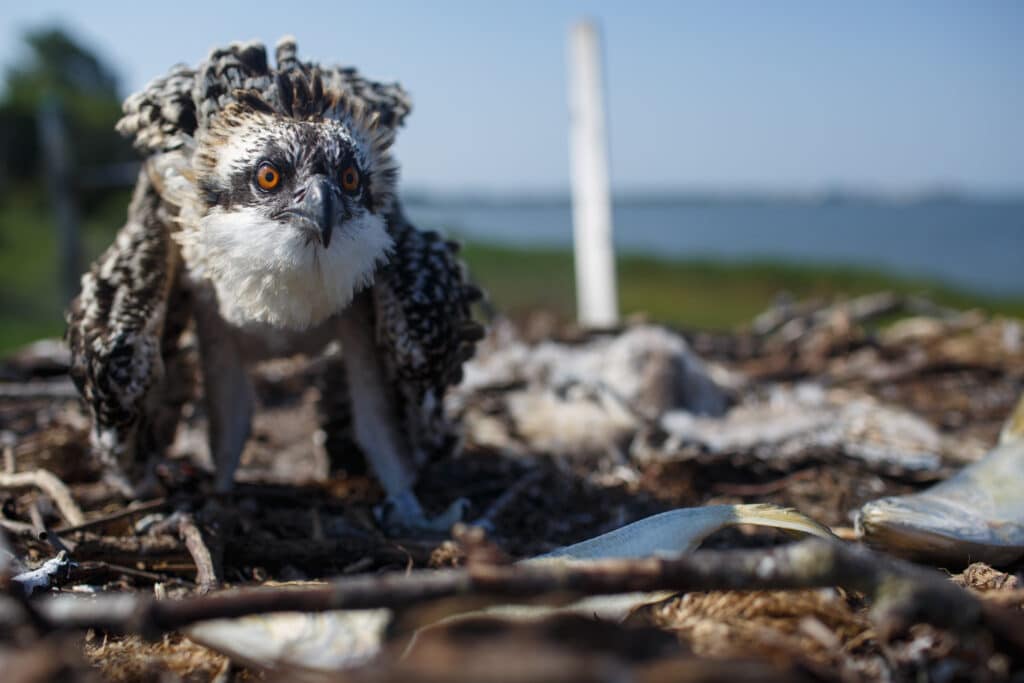Photo from the Field: Starving at the Shore

Since my last post on June 25, where I said this year was shaping up to be a “terrible one” for ospreys in New Jersey has held true. Since then I’ve watched as nestlings are abandoned and left to starve by their parents and die from starvation via live streaming cameras. It is heartbreaking. We’re seeing nest failure rates higher than they have ever been in most coastal colonies. Even worse, many others monitoring ospreys in surrounding states are reporting similar outcomes. Atlantic menhaden—typically a staple in the osprey’s diet—are far less abundant this season.
Over the past several weeks, myself and a small group of very dedicated volunteers and partner organizations have devoted much time to surveying osprey nests all along the coast. The data we collect, including nest occupancy and outcomes, allows us to help determine the health of the population. As mentioned above, our results are alarming.
Preliminary findings are illustrating that the failure witnessed first hand at the BL Osprey Cam and other osprey nest cams (TNC in Cape May, Wetlands Institute in Stone Harbor, Forsythe NWR in Oceanville) have become much more widespread. Results are indicating that ospreys are having a really difficult time finding sufficient prey to sustain their broods. Early in the season this caused pairs to lose their clutch of eggs. Many other pairs with hatchlings lost them too (the hatchling pictured in my previous post died). Then four and five week old nestlings went missing. Failure rates in some colonies are close to 90%, which is something that we have haven’t witnessed in a long time.
During some of my own surveys in areas surrounding Long Beach Island, including Sedge Island Wildlife Management Area, which is at the southern end of Island Beach State Park and one of the most densely populated colonies in New Jersey. This is where some of the first recovery efforts for ospreys began by Pete McLain and devoted biologists with NJ Fish & Wildlife. This year we surveyed a total of 37 occupied nests at Sedge. Only four nests were productive (1 w/ 2 nestlings, 3 w/ 1 nestling) as of July 25. At those four nests brood reduction occurred, which is a natural adaptation exhibited by ospreys when there is insufficient prey to support their entire brood and the youngest typically dies of starvation.
In this colony, 88% of nests failed to produce young. For comparison, in 2024 we surveyed a total of 37 nests at Sedge Island, 32 of which we determined the outcome. Of those a total of 55 young were produced. That’s a 90% decline in their productivity, which is a measure used to determine the overall health of the population. During that survey, I never witnessed an osprey colony that was so devoid of life. No adults, no young. Completely empty nest platforms. Not even any floating, non-breeding adults.
One thing is clear, there is a scarcity of forage fish that were previously readily available to ospreys, specifically adult Atlantic menhaden off mid-Atlantic states this year. We are seeing it through the lens of failed reproduction of ospreys, which are a very important bioindicator species. Other coastal states in this region are reporting the same thing and we should all be very concerned.
Menhaden are referred to as the most important fish in the sea and evolved to be eaten. They support many species of predatory birds, fish, and marine mammals in their various life stages in coastal waters. If there are too few menhaden to sustain osprey nest attempts, then the many other aquatic and avian species that depend on healthy numbers of them along the coast are also in jeopardy. Ospreys are telling us that something is wrong in the environment.
Data on adult menhaden abundance in New Jersey seems to be lacking. We are doing everything we can to record accurate results on nest outcomes to provide to the appropriate government agencies. Our work is funded by grants and donations. If you love ospreys and a healthy coastal ecosystem, please donate to support our work.
Discover more from Conserve Wildlife Foundation of NJ
Subscribe to get the latest posts sent to your email.
Leave a Comment
People have to get together to pressure NOAA and the Atlantic coast governors to stop omega protein from stripping by all the bunker from the Atlantic Ocean. This also will be a dooms day scenario for striped bass. We stopped the windmills we can stop omega protein.
Please explain more about omega protein…
This news from south Jersey is horrible! I have noticed a slight downward trend in production of osprey chicks in the northwest quadrant of NJ (west of Morristown and north of Trenton) where I do chick counts every year. These ospreys don’t eat menhaden, but what else is reducing productivity?? I hope we can mobilize, research, and figure this out. In my area it could just be the natural up and down variation during a decade or so, but still worrisome!
We are birders very familiar with several osprey nests ranging from Sea bright to Belmar. Have noticed definite decrease in babies. Didn’t know cause but nests that yearly had 2 or 3 babies seem devoid of any this year. I can think of a couple of nests where we’ve seen one baby.
Ben, thank you for this update. Absolutely devastating news. Which agencies could be tasked with looking into the decrease in menhaden numbers?
Thank you for posting this information! I have been a follower of the BL nest for several years. Do you think this decline in Osprey populations is cyclical? Pollution? Man?
Comments are closed.